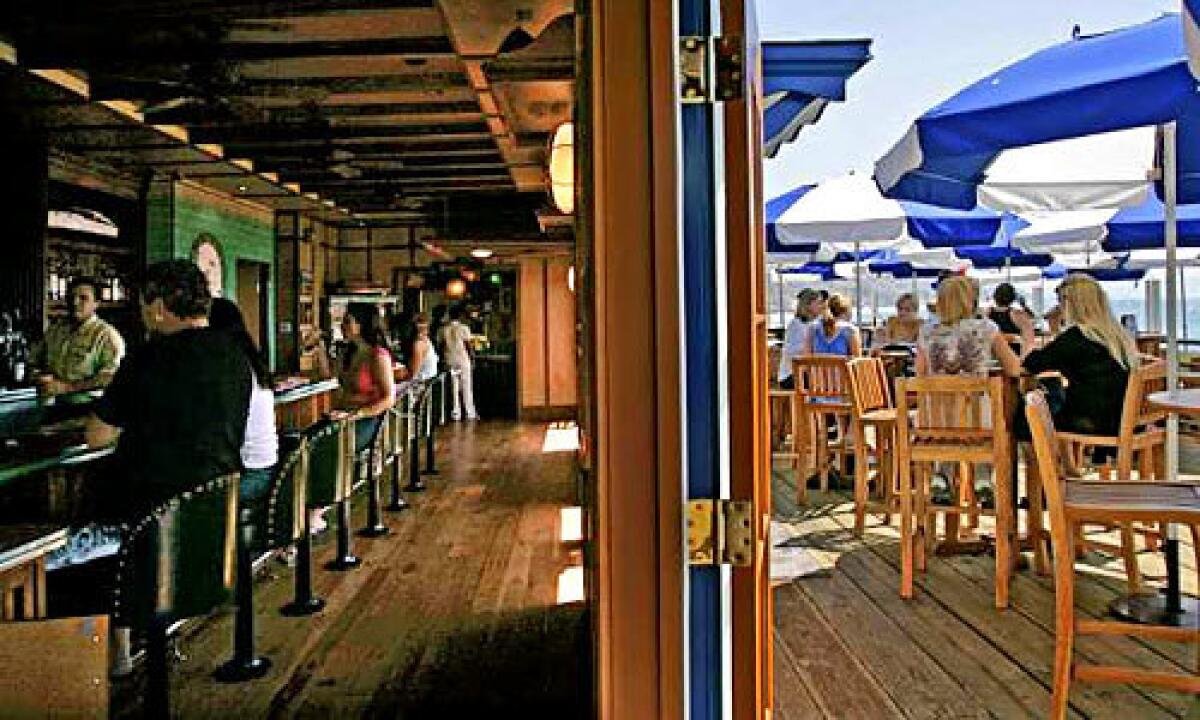Malibu Pier Club, Beachcomber Cafe turn back the clock

- Share via
IF YOU were building brand-new restaurants at the land end of Malibu Pier, chances are they wouldn’t look like the just-opened pair that currently boast that priceless view of the surf.
That’s precisely the point, said James Newland, supervising historian with the California State Parks, who helped oversee the restoration of the Malibu Pier, which recently reopened to the public.
The casual dining Malibu Pier Club and the finer-dining Beachcomber Cafe -- each had to be built within the footprints and remains of structures that dated back to the pier’s early days. Historic photographs that included aerial views as well as vintage home videos, helped builders fill in the gaps.
“The goal was to keep it to the historic period of the pier, the feel of 1945 to 1960,” Newland said. “It’s always a challenge for a commercial operator to come into a state park property, where our mission is about education and being open to the public.”
The pier, built in 1905, was a hot spot for film and TV shoots in addition to celebrity sports fishing. It even served as a lookout post during World War II. But it fell on hard times, in part due to storm damage, and was closed to the public in 1995. Since then, the state embarked on a multiyear effort to restore the pier. The pier
“The project had a number of constraints and challenges,” said Alexander Leff, principal with Malibu Pier Partners, the pier’s concessionaire, which came on board in 2005. “The pier is built out over the water. It’s made out of wood, much like an old wooden boat. The buildings are historic. The buildings were not handicapped accessible. . . . But we understood the constraints. Preserving that historic character and authenticity of the pier is what differentiates the pier from a shopping mall in the Valley.”
Restaurateur Doug Cavanaugh, who leases the Beachcomber and the Malibu Cafe from the concessionaire, came to the project with a track record. He earlier opened a restaurant -- also named the Beachcomber -- at historic Crystal Cove State Park in Orange County, so he was aware of the challenges to be faced.
Sometimes, though, an attempt at keeping it real was a bit too real.
At one point, restaurant plans called for extensive tile work that would have quite accurately recalled vintage Malibu Potteries tile. “It was an elaborate and detailed design that very much looked like tile artwork at the Adamson House,” Newland said.
But that would not have been accurate.
“You want to come up with something that reflects the feel and the period, but does not mimic historic features -- you don’t want to fool people, or create a false sense of history,” he said.
Highlights of the evocative details at the restaurants include porthole windows and other maritime touches, a tiki-themed bar inside the Malibu Pier Club that is made of authentic period decorative pieces, historic photographs that line the walls, and a flat screen showing vintage home movies of Malibu beach life in the ‘30s, ‘40s and ‘50s.
During those decades there were three sport fishing boats based at the Malibu Pier. The concessionaire tracked down the only surviving boat of the three, purchased it -- Leff won’t say for how much, just that it cost “a lot” -- and has returned it to service.
“The Malibu Pier is so beloved and iconic that we knew we were stewards of a very precious asset,” Leff said.
Added Newland: “I think people can walk through here and get the feeling ‘Hey, this is what it was like in the ‘50s’ and yet still have all the modern conveniences that we need to enjoy.”
More to Read
Sign up for The Wild
We’ll help you find the best places to hike, bike and run, as well as the perfect silent spots for meditation and yoga.
You may occasionally receive promotional content from the Los Angeles Times.











